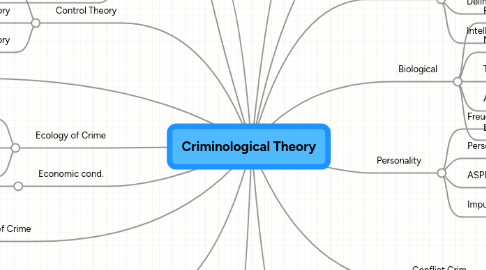Criminological Theory
rosie cuteにより

1. Classical
1.1. Beccaria & Classical Theory
1.2. NeoClassical theory
2. Economic cond.
2.1. Crime & Employment
3. Dukheim, Anomie & Modernization
3.1. Crime: Normal in Mechanical Society
3.2. "Anomie" - Pathological state of organis soc.
3.3. Durkheim's Theory of Crime
4. Critical Crim.
4.1. Marxism & Marxist
4.2. Marxist & Postmodernism
4.3. Feminism & Feminist
5. Ecology of Crime
5.1. Delinquent Area of Chicago
5.2. Situational Context
5.3. Neighborhood as Cause of Crime
6. Strain theory
6.1. Negative emotion & Inst. Anomie
6.2. Strain & Gang
6.3. Robert K. Merton
7. Learning Theory
7.1. basic Psycho.
7.2. Tarde's Law of Imitation
7.3. Sutherland's
7.4. Social learning Theory
8. Control Theory
8.1. Matza's Delinquency & Drift
8.2. Hirschi's Control theory
8.3. Gottfredson + Hirschi's General theory
9. Meaning of Crime
9.1. General Theory
9.2. Crime & The Self
9.3. Labeling Theory
9.4. Deviance & Social Reaction
10. Positivist
10.1. Guery & Quetelet
10.2. Casare Lombrosso
10.3. Positivist vs. Classical
11. Physical Appearance
11.1. Phsyiognomy & Phrenology
11.2. Criminal Anthropology
11.3. Lombroso to Goring
11.4. Sheldon to Cortes - Body Type
12. Intelligence
12.1. The Bell Curve
12.2. Delinquency & IQ
12.3. Delinquency, Race & IQ
12.4. Intelligence Testing & Crime
13. Biological
13.1. Family Studies
13.2. Neurotransmitter & Hormones
13.3. Twin & Adoption Theories
13.4. ANS & CNS
13.5. Enviro. Induced Biological Comp. of Behav.
14. Personality
14.1. Freud & Psychoanalysis
14.2. Personality test
14.3. ASPD
14.4. Impulsivity & Crime
15. Conflict Crim.
15.1. Chambliss & Seidman's Analysis of Crim Just System
15.2. Sellin's Culture Conflict Theory
15.3. Hagan's Structure Crim.
15.4. Quinney's Soc. Reality of Crim
15.5. Turk's Theory of Criminalist
15.6. Vold's Gp Conflict Theory
15.7. McGarall & Castellano Integ. Cloflict Model
16. Developmental Crim.
16.1. CrimCareer: Longitudinal Research, Relationship - age & crime
16.2. Criminal Propensity & Career
16.3. Thorberry's Interactional
16.4. Sampson & Laub's Age-Graded theory of Informal Soc. Control


